
# 572 - 1923 $2 Capitol, deep blue
U.S. #572 was first issued on March 20, 1923. Small quantities were released each year for the next eleven years. In total, only two million #572 stamps were issued over a twelve-year period. That’s less than the quantity issued in one year for most other issues during that time.
Washington Lays Cornerstone Of U.S. Capitol

On September 18, 1793, President George Washington laid the cornerstone of the U.S. Capitol building in Washington, D.C.
Philadelphia was America’s first capital city starting in 1774. In 1787, the delegates at the Philadelphia Convention granted Congress the power “To exercise exclusive legislation in all cases whatsoever, over such District (not exceeding 10 miles square) as may, by cession of particular states, and the acceptance of Congress, become the seat of government of the United States.” James Madison added that the national capital should be separate from the rest of the states, being responsible for its own maintenance and security.
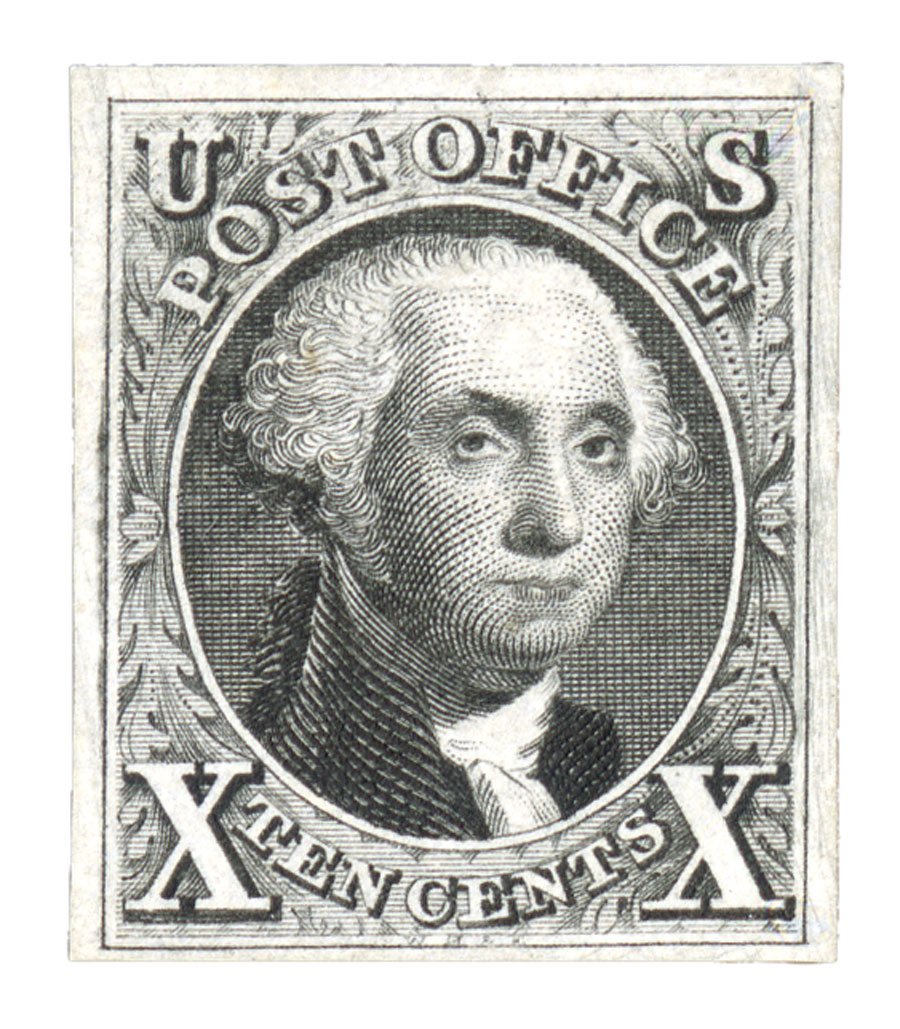
Maryland, New Jersey, New York, and Virginia all offered territory for the capital. Eventually, James Madison, Thomas Jefferson, and Alexander Hamilton selected the area around the Potomac River to serve as the national capital.
By 1789, Maryland and Virginia ceded a combined 100 square miles to serve as the capital. Two years later, President George Washington appointed three commissioners to oversee the planning, design, and creation of property. They named the Federal District “The Territory of Columbia,” and the Federal City “The City of Washington.”
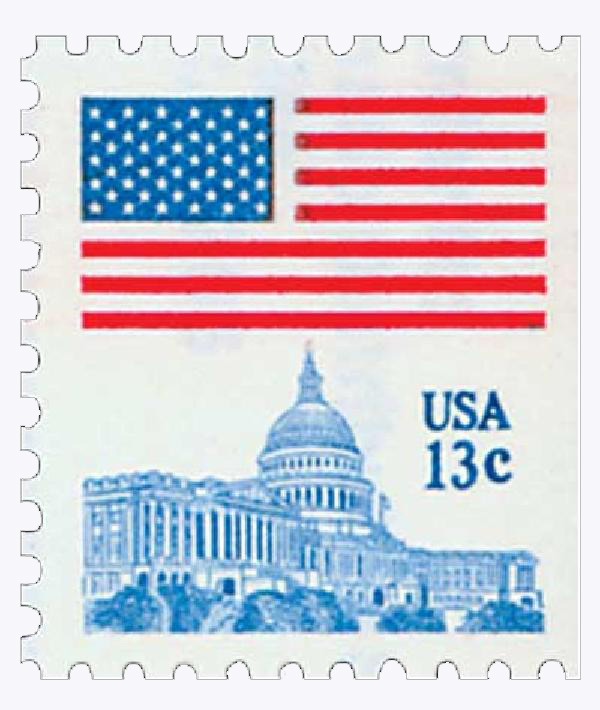
Around this time, President Washington hired Pierre Charles L’Enfant to design the capital city at the center of the federal territory. L’Enfant’s plan revolved around the U.S. Capitol Building on top of Jenkins Hill with wide diagonal avenues crossing the city’s layout. He also designed the narrow Pennsylvania Avenue to connect the Capitol Building and White House. After L’Enfant became involved in several conflicts with the city’s commissioners and refused to provide planners with an engraved city plan, he was let go. Andrew Ellicot made several changes to L’Enfant’s plan and had it engraved, making it the first distributed plan of the city.
However, with L’Enfant’s departure, a new architect was needed to design the Capitol and President’s House (now the White House). Thomas Jefferson suggested they hold a design competition. Though most of the Capitol building designs were unusable, President Washington praised a late entry by William Thornton for its “Grandeur, Simplicity, and Beauty.” Thornton’s design was in part inspired by the east front of the Louvre as well as the Paris Pantheon. His design was approved, with modifications by Benjamin Henry Latrobe, and planning began immediately.
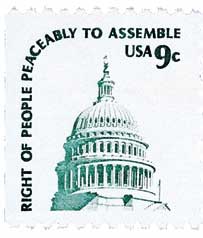
Excavation of the Capitol site began in July 1793. Two months later, they were ready to lay the cornerstone. At 10:00 a.m. on September 18, President Washington crossed the Potomac into the capital city where he was joined by the Alexandria Volunteer Artillery and members of the Virginia and Maryland Masonic lodges. Marching 1.5 miles to the construction site, Washington met with Grand Master of the Grand Lodge of Maryland, Joseph Clark. Clark handed Washington a silver plaque that read
“This South East corner Stone, of the Capitol of the United States of America in the City of Washington, was laid on the 18th day of September 1793, in the thirteenth year of American Independence, in the first year of the second term of the Presidency of George Washington, whose virtues in the civil administration of his country have been as conspicuous and beneficial, as his Military valor and prudence have been useful in establishing her liberties, and in the year of Masonry 5793, by the Grand Lodge of Maryland, several Lodges under its jurisdiction, and Lodge No. 22, from Alexandria, Virginia.”
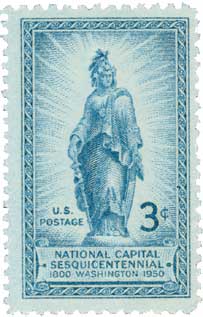
Following Masonic rituals, the cornerstone was then checked with a square, level, and plumb (a tool used to ensure the stone was upright) and deemed perfectly cut. It was then sprinkled with wheat (a symbol of nourishment), wine (for health and refreshment), and oil (for peace and tranquility). Washington then tapped the stone three times with a gavel (part of Masonic tradition) and marched away to a 15-gun salute.
Though still under construction, the first session of Congress in the Capitol was held on November 17, 1800. The rest of the building was completed a few years later, only to be burned by the British during the War of 1812. Luckily, it was saved from total destruction by a sudden rainstorm. Latrobe was contracted to restore the building after the fire, but resigned when criticized for the cost of the project. He was replaced by prominent Boston architect, Charles Bulfinch, who completed the restoration in 1826. Bulfinch rebuilt the dome with a larger, copper-covered wooden version. However, that wasn’t the end of changes to this magnificent structure. In 1855 Thomas Ustick Walter designed a new fireproof cast iron dome weighing almost 9 million pounds! This new dome had to be lifted into place by steam-powered derricks.
When the Civil War erupted in 1861, President Lincoln insisted work continue on the Capitol, claiming, “If people see the Capitol going on, it is a sign we intend the Union shall go on.” And in 1863 the Statue of Freedom designed by Thomas Crawford was placed atop the dome. The statue features a female symbolizing freedom draped in classical robes. Her left hand holds a laurel wreath of victory and the shield of the U.S. with 13 stripes. She wears a helmet encircled by stars and topped by an eagle’s head and talons. The statue weighs nearly 15,000 pounds and is over 19 feet tall.
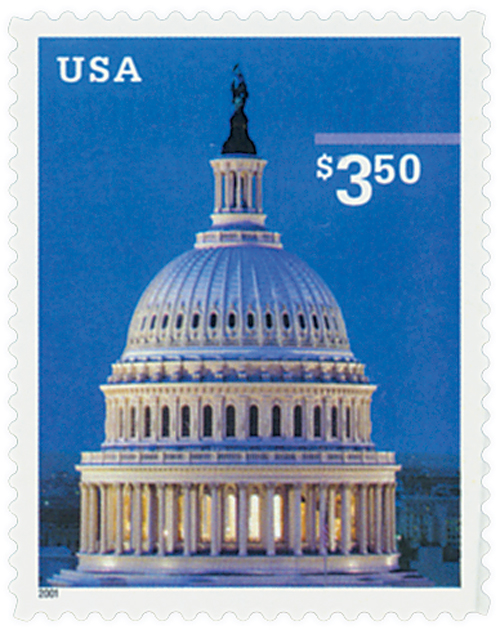
The cornerstone laid by Washington has been lost to time. Some believe it was removed and destroyed when the Senate chambers were built in 1850. In 1893, President Grover Cleveland led the centennial rededication of the Capitol, attended by some 150,000 people. He followed the same route as Washington and was also accompanied by Masons, as well as other societies including the Cincinnati, Sons of the Revolution, and the Aztec Club. The U.S. Marine Band played while a 1,500-person choir sang. This was followed by a two-hour speech from William Wirt Henry, grandson of Patrick Henry. A much smaller bicentennial ceremony was held in 1993.
Click here and here to see artist’s depictions of Washington laying the cornerstone.
Click here to see more stamps honoring the U.S. Capitol building.
This $2 Stamp Was Expensive to Acquire in 1923
Two dollars was worth a great deal more in 1923. Consider this: when adjusted for inflation, $2 in 1923 would be worth over $100 in wages today! Obviously, many stamp collectors were unable to invest in such an expensive stamp.
New 1922 Series Subject of Widespread Newspaper Publicity
In 1922, the Post Office Department announced it was considering a new series of stamps to replace the then-current Washington/Franklin stamps, which had been in use with relatively few changes since 1908. Naturally the news resulted in widespread newspaper publicity. And while some papers, such as the Cleveland Plain Dealer, were in favor of the new series, many papers criticized the change, stating the new stamps were only being produced to satisfy collectors.
Postmaster General W. Irving Glover denied the statements. Rather he attributed the change to the thousands of letters he had received from postal employees requesting the production of new stamps with distinct variations in designs and colors. Due to the striking similarity of the current stamps, thousands of dollars in revenue were being lost each year.
A Symbol of Our American Heritage
The $2 U.S. Capitol stamp was part of the new series. In addition to creating distinctly different stamps, the Post Office also worked to produce stamps which were interesting and attractive. The new stamps featured many prominent Americans, along with scenes of national interest. Originally slated to be used on the 50¢ stamp, the Capitol building was eventually chosen as the design on the $2 stamp.
A symbol of our American heritage, the Capitol building has been the scene of many pivotal events in American history. Since its completion in 1795, the Capitol has been the powerhouse of our government. Even today, the House of Representatives and the Senate meet here to make the decisions that continue to affect our lives.
The Capitol’s 540 rooms hold mementos of U.S. history as well as paintings and statues by world-famous artists. The building also houses the old Supreme Court chamber where the court met from 1810-1860, and the famous Statuary Hall.
U.S. #572 was first issued on March 20, 1923. Small quantities were released each year for the next eleven years. In total, only two million #572 stamps were issued over a twelve-year period. That’s less than the quantity issued in one year for most other issues during that time.
Washington Lays Cornerstone Of U.S. Capitol

On September 18, 1793, President George Washington laid the cornerstone of the U.S. Capitol building in Washington, D.C.
Philadelphia was America’s first capital city starting in 1774. In 1787, the delegates at the Philadelphia Convention granted Congress the power “To exercise exclusive legislation in all cases whatsoever, over such District (not exceeding 10 miles square) as may, by cession of particular states, and the acceptance of Congress, become the seat of government of the United States.” James Madison added that the national capital should be separate from the rest of the states, being responsible for its own maintenance and security.

Maryland, New Jersey, New York, and Virginia all offered territory for the capital. Eventually, James Madison, Thomas Jefferson, and Alexander Hamilton selected the area around the Potomac River to serve as the national capital.
By 1789, Maryland and Virginia ceded a combined 100 square miles to serve as the capital. Two years later, President George Washington appointed three commissioners to oversee the planning, design, and creation of property. They named the Federal District “The Territory of Columbia,” and the Federal City “The City of Washington.”

Around this time, President Washington hired Pierre Charles L’Enfant to design the capital city at the center of the federal territory. L’Enfant’s plan revolved around the U.S. Capitol Building on top of Jenkins Hill with wide diagonal avenues crossing the city’s layout. He also designed the narrow Pennsylvania Avenue to connect the Capitol Building and White House. After L’Enfant became involved in several conflicts with the city’s commissioners and refused to provide planners with an engraved city plan, he was let go. Andrew Ellicot made several changes to L’Enfant’s plan and had it engraved, making it the first distributed plan of the city.
However, with L’Enfant’s departure, a new architect was needed to design the Capitol and President’s House (now the White House). Thomas Jefferson suggested they hold a design competition. Though most of the Capitol building designs were unusable, President Washington praised a late entry by William Thornton for its “Grandeur, Simplicity, and Beauty.” Thornton’s design was in part inspired by the east front of the Louvre as well as the Paris Pantheon. His design was approved, with modifications by Benjamin Henry Latrobe, and planning began immediately.

Excavation of the Capitol site began in July 1793. Two months later, they were ready to lay the cornerstone. At 10:00 a.m. on September 18, President Washington crossed the Potomac into the capital city where he was joined by the Alexandria Volunteer Artillery and members of the Virginia and Maryland Masonic lodges. Marching 1.5 miles to the construction site, Washington met with Grand Master of the Grand Lodge of Maryland, Joseph Clark. Clark handed Washington a silver plaque that read
“This South East corner Stone, of the Capitol of the United States of America in the City of Washington, was laid on the 18th day of September 1793, in the thirteenth year of American Independence, in the first year of the second term of the Presidency of George Washington, whose virtues in the civil administration of his country have been as conspicuous and beneficial, as his Military valor and prudence have been useful in establishing her liberties, and in the year of Masonry 5793, by the Grand Lodge of Maryland, several Lodges under its jurisdiction, and Lodge No. 22, from Alexandria, Virginia.”

Following Masonic rituals, the cornerstone was then checked with a square, level, and plumb (a tool used to ensure the stone was upright) and deemed perfectly cut. It was then sprinkled with wheat (a symbol of nourishment), wine (for health and refreshment), and oil (for peace and tranquility). Washington then tapped the stone three times with a gavel (part of Masonic tradition) and marched away to a 15-gun salute.
Though still under construction, the first session of Congress in the Capitol was held on November 17, 1800. The rest of the building was completed a few years later, only to be burned by the British during the War of 1812. Luckily, it was saved from total destruction by a sudden rainstorm. Latrobe was contracted to restore the building after the fire, but resigned when criticized for the cost of the project. He was replaced by prominent Boston architect, Charles Bulfinch, who completed the restoration in 1826. Bulfinch rebuilt the dome with a larger, copper-covered wooden version. However, that wasn’t the end of changes to this magnificent structure. In 1855 Thomas Ustick Walter designed a new fireproof cast iron dome weighing almost 9 million pounds! This new dome had to be lifted into place by steam-powered derricks.
When the Civil War erupted in 1861, President Lincoln insisted work continue on the Capitol, claiming, “If people see the Capitol going on, it is a sign we intend the Union shall go on.” And in 1863 the Statue of Freedom designed by Thomas Crawford was placed atop the dome. The statue features a female symbolizing freedom draped in classical robes. Her left hand holds a laurel wreath of victory and the shield of the U.S. with 13 stripes. She wears a helmet encircled by stars and topped by an eagle’s head and talons. The statue weighs nearly 15,000 pounds and is over 19 feet tall.

The cornerstone laid by Washington has been lost to time. Some believe it was removed and destroyed when the Senate chambers were built in 1850. In 1893, President Grover Cleveland led the centennial rededication of the Capitol, attended by some 150,000 people. He followed the same route as Washington and was also accompanied by Masons, as well as other societies including the Cincinnati, Sons of the Revolution, and the Aztec Club. The U.S. Marine Band played while a 1,500-person choir sang. This was followed by a two-hour speech from William Wirt Henry, grandson of Patrick Henry. A much smaller bicentennial ceremony was held in 1993.
Click here and here to see artist’s depictions of Washington laying the cornerstone.
Click here to see more stamps honoring the U.S. Capitol building.
This $2 Stamp Was Expensive to Acquire in 1923
Two dollars was worth a great deal more in 1923. Consider this: when adjusted for inflation, $2 in 1923 would be worth over $100 in wages today! Obviously, many stamp collectors were unable to invest in such an expensive stamp.
New 1922 Series Subject of Widespread Newspaper Publicity
In 1922, the Post Office Department announced it was considering a new series of stamps to replace the then-current Washington/Franklin stamps, which had been in use with relatively few changes since 1908. Naturally the news resulted in widespread newspaper publicity. And while some papers, such as the Cleveland Plain Dealer, were in favor of the new series, many papers criticized the change, stating the new stamps were only being produced to satisfy collectors.
Postmaster General W. Irving Glover denied the statements. Rather he attributed the change to the thousands of letters he had received from postal employees requesting the production of new stamps with distinct variations in designs and colors. Due to the striking similarity of the current stamps, thousands of dollars in revenue were being lost each year.
A Symbol of Our American Heritage
The $2 U.S. Capitol stamp was part of the new series. In addition to creating distinctly different stamps, the Post Office also worked to produce stamps which were interesting and attractive. The new stamps featured many prominent Americans, along with scenes of national interest. Originally slated to be used on the 50¢ stamp, the Capitol building was eventually chosen as the design on the $2 stamp.
A symbol of our American heritage, the Capitol building has been the scene of many pivotal events in American history. Since its completion in 1795, the Capitol has been the powerhouse of our government. Even today, the House of Representatives and the Senate meet here to make the decisions that continue to affect our lives.
The Capitol’s 540 rooms hold mementos of U.S. history as well as paintings and statues by world-famous artists. The building also houses the old Supreme Court chamber where the court met from 1810-1860, and the famous Statuary Hall.

























